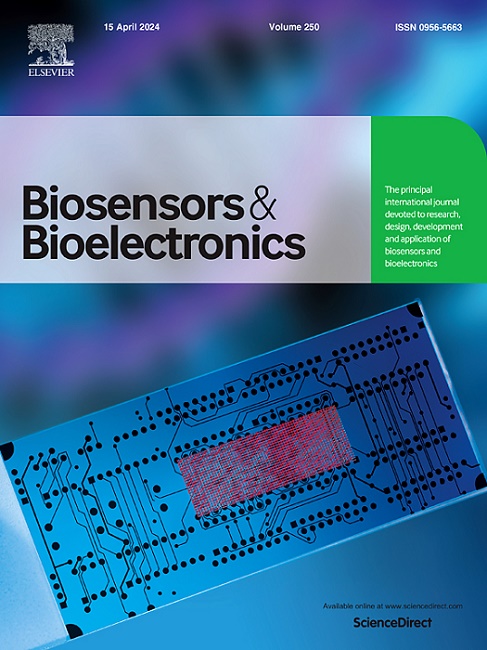High-throughput and high-sensitive direct detection for pathogenic bacteria of urinary tract infections mediated by block-based design of flexible non-metallic composite SERS substrate
IF 10.7
1区 生物学
Q1 BIOPHYSICS
引用次数: 0
Abstract
It remains a huge challenge to realize a high-throughput direct detection for pathogenic bacteria with high-sensitivity in practice. Here, we develop a typical two-dimensional (2D) composite semiconductor of BP@MoS2 with special synergistic chemical enhancement-mediated surface-enhanced Raman scattering (SERS) activity. The relative proportion of MoS2 and BP was rationally adjusted in the hydrothermal reaction to screen a composite sample with high charge transfer efficiency. Furthermore, the optimal BP@MoS2 nanocomposites were integrated with polydimethylsiloxane (PDMS) film based on a hydrophilic-hydrophobic scheme to improve the collection and on-site monitoring capability of SERS substrate. Unlike the conventional detection chip, this hydrophilic-hydrophobic model could facilitate the block design of active areas on the PDMS matrix, which was benefit for the high-throughput detection. More importantly, this SERS substrate was applied to directly monitor urinary tract pathogens of Escherichia coli, facilitating satisfactory recoveries between 90% and 110%. Overall, the as-proposed PDMS-BP@MoS2 SERS substrate exhibited advantages in the collection, quantification, and high-throughput fingerprint recognition of pathogenic bacteria, offering a new avenue for the clinical detection.
基于块体设计的柔性非金属复合 SERS 基底可高通量、高灵敏度地直接检测尿路感染的致病菌
在实践中,如何实现高灵敏度、高通量地直接检测病原菌仍然是一个巨大的挑战。在此,我们开发了一种具有特殊协同化学增强介导的表面增强拉曼散射(SERS)活性的典型二维(2D)BP@MoS2 复合半导体。通过合理调整水热反应中 MoS2 和 BP 的相对比例,筛选出了具有高电荷转移效率的复合样品。此外,基于亲水-疏水方案,将最优的 BP@MoS2 纳米复合材料与聚二甲基硅氧烷(PDMS)薄膜集成,提高了 SERS 基底的收集和现场监测能力。与传统的检测芯片不同,这种亲水疏水模式可以方便地在 PDMS 基质上分块设计活性区,有利于高通量检测。更重要的是,这种 SERS 基质被用于直接监测大肠杆菌的尿路病原体,回收率在 90% 到 110% 之间,令人满意。总之,所提出的 PDMS-BP@MoS2 SERS 底物在病原菌的收集、定量和高通量指纹识别方面具有优势,为临床检测提供了一条新途径。
本文章由计算机程序翻译,如有差异,请以英文原文为准。
求助全文
约1分钟内获得全文
求助全文
来源期刊

Biosensors and Bioelectronics
工程技术-电化学
CiteScore
20.80
自引率
7.10%
发文量
1006
审稿时长
29 days
期刊介绍:
Biosensors & Bioelectronics, along with its open access companion journal Biosensors & Bioelectronics: X, is the leading international publication in the field of biosensors and bioelectronics. It covers research, design, development, and application of biosensors, which are analytical devices incorporating biological materials with physicochemical transducers. These devices, including sensors, DNA chips, electronic noses, and lab-on-a-chip, produce digital signals proportional to specific analytes. Examples include immunosensors and enzyme-based biosensors, applied in various fields such as medicine, environmental monitoring, and food industry. The journal also focuses on molecular and supramolecular structures for enhancing device performance.
 求助内容:
求助内容: 应助结果提醒方式:
应助结果提醒方式:


